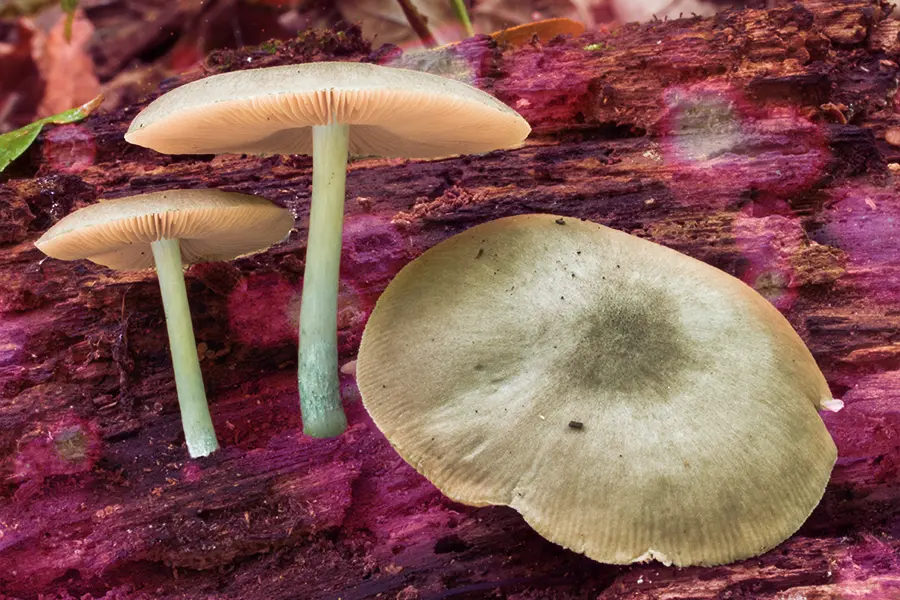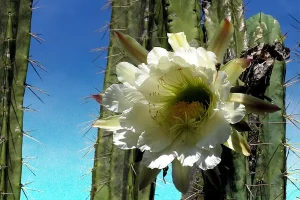When most people think of magic mushrooms, they usually think of Psilocybe cubensis. They might also think of other species in the Psilocybe genus, from which Albert Hofmann isolated the active compounds psilocybin and psilocin in the late 1950s. This association makes a lot of sense: Of the over 200 species of psilocybin-containing mushrooms, nearly 150 belong to the genus Psilocybe. However, Psilocybe aren’t the only fungi that contain the psychedelic. Some less common mushroom genera, like Panaeolus, Gymnopilus, and Inocybe, produce psilocybin as well. One of these lesser-known psilocybin-containing species is Pluteus americanus—the mushroom we’re covering today.
American mycologist Alexander Smith first collected this mushroom in Michigan in 1957. At first, mycologists thought this mushroom was a distinct variety of the willow shield mushroom (Pluteus salicinius). So, it was named Pluteus salicinius var. americanus by the late mycologist Dr. Walter J. Sundberg and mycologist turned human rights journalist Dr. Partha Banerjee in 1993. But genetic studies in 2014 proved otherwise. Studies conducted by Alfredo Justo and colleagues found that this mushroom variety was, in fact, a separate species. Its Latin name was updated to Pluteus americanus, honoring the original varietal name and highlighting that this mushroom is found almost, but not exclusively, in North America.
A close look at the etymology of any species’ Latin name tends to highlight something interesting about its physical characteristics; fungi are no different. While the epithet “americanus” refers to where you can find this mushroom most often, the genus name “Pluteus” is Latin for a protective fence or screen. You’ll often see the word “shield” used in common names for these species.
Same psychedelic compound, different species
How have so many different species of otherwise distantly-related fungi come to produce psilocybin? These mushroom-forming species can’t interbreed in the present and don’t appear to share a common psilocybin-containing ancestor from way back in their past, so it seems implausible that so many could contain the same compound. Scientists think the secret to this puzzle stems from horizontal gene transfer, which could be linked to many of these different mushroom species having similar ecological roles in breaking down dead matter.
READ: Types of Magic Mushrooms: 10 Shroom Strains You Should Know About
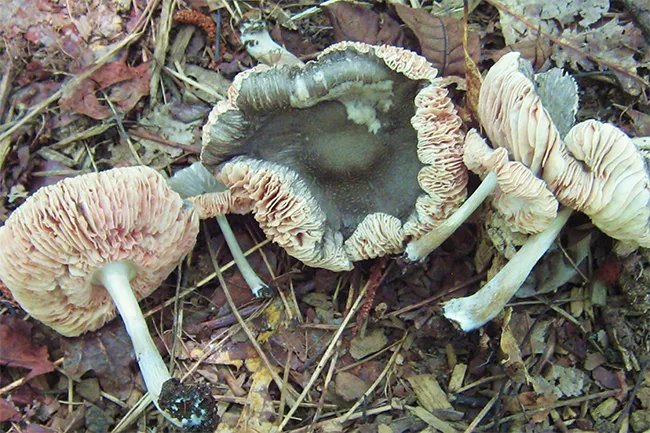
To use a somewhat overly simplistic analogy, if humans could deploy horizontal gene transfer, this might be the equivalent of being able to platonically but permanently copy and paste desirable genes from your friends or co-workers into your own genetic code. If you wanted your friend’s great taste in music, your colleague’s heightened emotional intelligence, or your gym buddy’s ability to run laps without getting out of breath, horizontal gene transfer would allow you to do this. Unfortunately, however, this biological ability is mainly limited to microbes like fungi, bacteria, and viruses, though research is currently ongoing into its occurrence in animals and plants.
Some scientists believe that psilocybin and psilocin are created in these decay-associated fungi to discourage insects from eating them before their mushrooms have shed their spores. By sharing the genes responsible for making psilocybin, the hypothesis goes, all mushrooms in this ecological niche gain a similar advantage. Despite narratives of the natural world as a combative, species-vs-species environment, in the case of horizontal gene transfer, sometimes nature is more cooperative than we give it credit for.
Pluteus americanus Potency
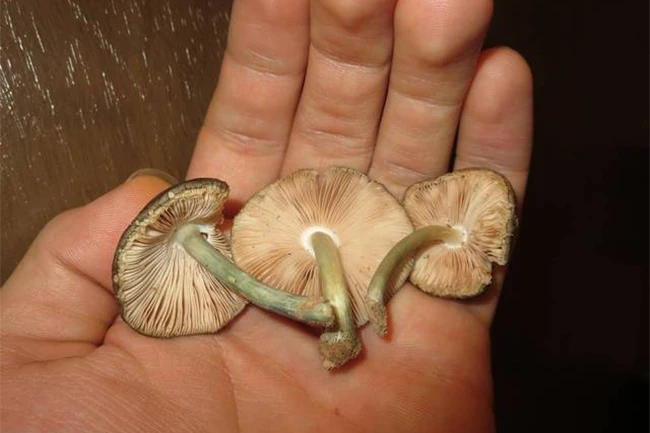
There are few reports on the chemical components of Pluteus americanus. Still, the most reliable and comprehensive estimate of alkaloid concentration is probably from a paper published by Klára Gotvaldová and colleagues in 2022. This study measured the potency of Pluteus americanus in the region of 0.12-0.24 percent psilocybin, 0.01-0.03 percent psilocybin, 0.02-0.04 percent baeocystin, 0.007-0.02 percent norbaeocystin, and 0.0008-0.001 percent aeruginascin. Ranges like this place Pluteus americanus at about one-half to a third as potent as the grower’s favorite, Psilocybe cubensis. (Well, if you ignore particularly potent varieties like Penis Envy.)
How to Grow Shrooms Bundle
Take Both of Our Courses and Save $90!
Furthermore, chemical analyses of American Pluteus salicinus made before 2014—when the new species of Pluteus americanus was verified genetically—may be attributed to the wrong species. If so, this further confuses potency estimates. Notes on the potency of Pluteus salicinus and Pluteus americanus suggest that, like many magic mushrooms, the potency may vary between individual and batches of mushrooms growing in different places.
Where Can I Find Pluteus americanus?
As the Latin name suggests, Pluteus americanus is found almost exclusively in North America and eastern Canada. Many observations are recorded around the Appalachian Mountains and north towards the Great Lakes. Lucky mycologists also spotted Pluteus americanus growing in Arizona and California, suggesting it may be widely distributed throughout North America. Interestingly, the original genetic studies published in 2014 revealed that Pluteus americanus has also been found in eastern Russia, near the Chinese and North Korean border, suggesting its geographical range may be even wider than we currently believe—as well as a warning to other mycologists about the slightly embarrassing consequences of naming a newly discovered mushroom after the country you found it in.
Habitat, Range, and Season
Pluteus americanus is a wood-loving species and found growing on hardwoods like ash (Fraxinus) and cottonwood (Populus), along with birch (Betula) and maple (Acer). As a result, you’re most likely to find Pluteus americanus growing in forests containing lots of these tree species. The best time of year to find these mushrooms is between July to October.
Pluteus americanus Identification
Pluteus americanus grows alone or in small scattered groups. Their caps can reach around 2 ¼ inches (6 cm) in diameter. When young, the brownish-gray caps of Pluteus americanus are rounded or bell-shaped (campanulate), which open up to almost flat in older specimens. The surface of the cap is usually covered in small darker scales towards the center, becoming lighter and smoother towards the edges. Similarly to many Psilocybe species, Pluteus americanus has a hygrophanous cap, meaning that it changes color as it dries out—in this case, getting lighter.
READ: How To Identify Magic Mushrooms
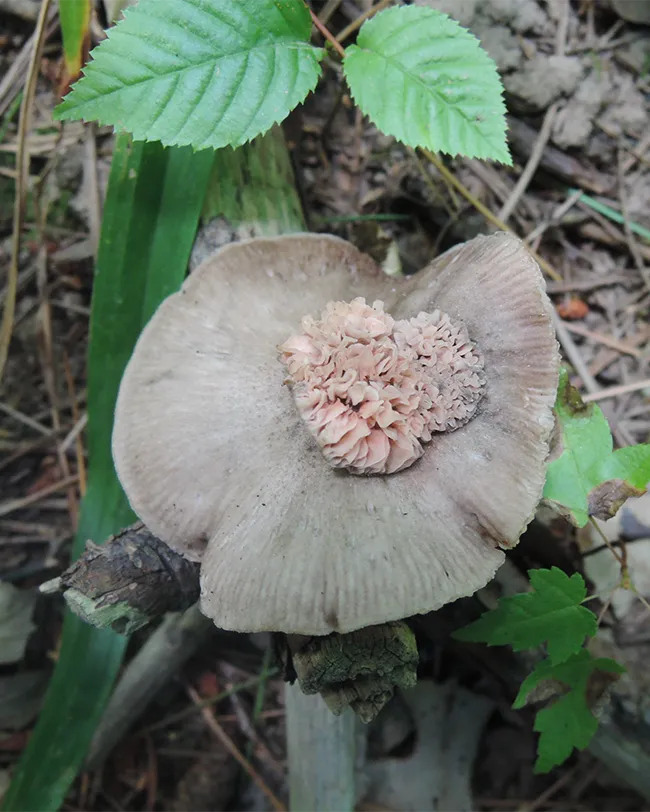
Underneath the cap, the crowded gills of this mushroom gently curve out below the edge of the cap. The gills start off white in younger mushrooms and turn pink as the mushroom ages.
The straight stem of Pluteus americanus grows to around 2 ½ inches (6.5 cm) tall and ¼ inch (0.6 cm) thick and may be slightly swollen at the base. The surface of the stem is usually white but can be covered in tinges of bluish-green, especially near the base. Unlike some other mushroom species, there is no ring around the stem. Both the stem and cap of Pluteus americanus may stain blue when damaged.
One particularly interesting feature of Pluteus americanus is that it is said to smell slightly like the leaves of plants from the genus Pelargonium, a group of fragrant flowering plants popular with gardeners and used by the perfume industry.
Pluteus americanus Spore Print
Unlike psilocybin-containing mushrooms in the genus Psilocybe, which have a purplish-black spore print, the spores of Pluteus americanus leave a pink to pinkish-brown print.
Pluteus americanus Look-alikes
Always take great care when foraging for any mushrooms, including psilocybin-containing species like Pluteus americanus. Ethical foraging involves respect for the land, the cultures that traditionally use psychoactive fungi, and a deep caution when identifying mushrooms to eat. If you’re anything but 100 percent certain you have the right mushroom, it’s best to leave it alone. Local mushroom groups and online resources like The Shroomery, iNaturalist, and Mushroom Observer can help you with your positive identification.
Given the recent 2014 discovery of Pluteus americanus as a distinct species, this mushroom is often confused with others in the Pluteus genus, especially the willow shield mushroom Pluteus salicinus. However, true Pluteus salicinus likely only grows in Europe, with records from North America possibly misattributed before 2014, when mycologists determined that Pluteus americanus is a distinct species. There are few records of poisonings associated with any mushrooms in the Pluteus genus, though it still pays for beginners to take extra care when trying to identify this species.
Other look-alike species that contain some psilocybin include Pluteus glaucotinctus, Pluteus glaucus, Pluteus nigroviridis, and possibly Pluteus ephebus (formerly known as Pluteus villosus in some identification guides). Some Pluteus americanus look-alikes, like the deer shield mushroom (Pluteus cervinus), are gathered by foragers to use in cooking. Given the number of species in this genus known to contain psilocybin, rather than misidentifying a psychedelic mushroom for a poisonous one, there may be an arguably greater risk posed by Pluteus americanus and its psychedelic relatives to those hoping only for a meal!
Consuming Pluteus americanus
Though Pluteus americanus grows on wood, its consumption is not yet implicated in cases of wood lover’s paralysis, a mysterious condition associated more commonly with the consumption of wood-loving Psilocybe species. However, absence of evidence is never evidence of absence, and the lack of reported association may be due to its lesser popularity as a commonly consumed magic mushroom. Until we know more about wood lover’s paralysis, and given the variations in potency between magic mushrooms, it may be wise to dose Pluteus americanus with caution.
Health risks aside, please remember that possessing psilocybin-containing mushrooms—even wild-foraged mushrooms—is still illegal in most parts of the world. As such, always consider the local laws in your area before foraging or engaging with these mushrooms. Although decriminalization movements are underfoot, possessing psilocybin always comes with a risk in areas where prohibition is still the norm.
Interested in having a psychedelic experience, but don't know where to start? Get our definitive guide on trusted legal retreat centers, clinical trials, therapists, and more.
